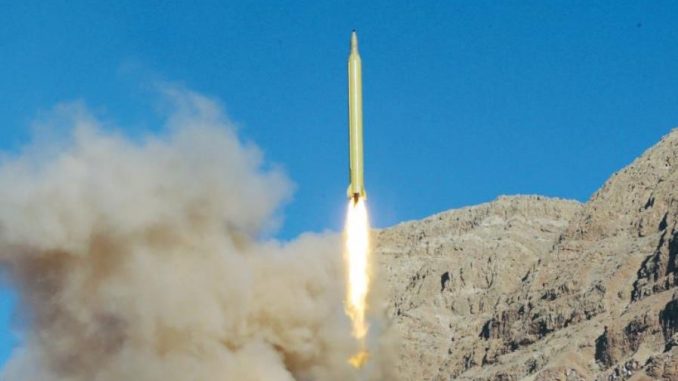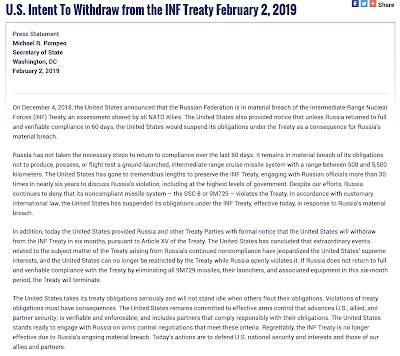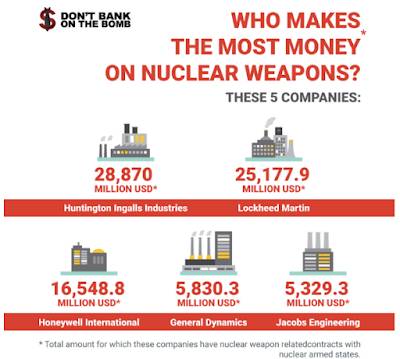
Back in February 2019, Donald Trump announced that the United States was giving six months notice that it intended to withdraw from the Intermediate-Range Nuclear Forces (or INF) Treaty which was signed in 1987 to keep nuclear missiles out of Europe. The INF treaty banned the use of ground-launch nuclear missiles with a range of between 500 and 5,000 kilometres. This followed an announcement on December 4, 2018 in which the United States announced that Russia was in material breach of its obligations under the INF Treaty and demanded that Russia return to full and verifiable compliance within 60 days, which, according to the U.S. Department of State, it did not as shown in this press statement by Secretary of State and Chief war co-sponsor, Michael Pompeo:
Note that in the press release, the Secretary stated that "…the United States remains committed to effective arms control that advances U.S., allied and partner security...". Let's look at just how committed the United States is to security, particularly of the nuclear variety.
According to a recent report entitled "Producing Mass Destruction: Private Companies and the Nuclear Weapons Industry" by Pax For Peace, a Netherland's-based peace organization, several American companies are benefitting from tens of billions of dollars in sales as part of their business model to build nuclear weapons or components for these weapons that have absolutely no redeeming value to humanity. Let's look at America's top three defense contractors (according to DefenseNews) and their very strong connections to our nuclear weapon world by examining just some of the contracts that the companies have received for nuclear weapons-related work:
1.) Lockheed Martin: The company, the world's largest weapons producer, is responsible for construction of the Trident II missile which will be used on the new Ohio Class submarines. A July 2014 contract for $19.9 million for the initial phases of the Trident II development was modified and under the new terms could reach a total maximum of $828.4 million. Other contracts have also been issued for Trident II missile production, technical support etcetera as follows (including both the original contract amount and the maximum that could be reached if all options are exercised:
November 2014 – $35.9 million – $99.2 million maximum
April 2015 – $31.1 million
September 2015 – $392 million – maximum of $1.5 billion
April 2016 – $12 million and $21 million
February 2017 – $540 million plus $125.5 million for modifications
April 2017 – $11 million
September 2017 – $418.7 million – maximum of $1.1 billion
September 2017 – $55.7 million – maximum $108.6 million
December 2017 – $154.4 million
March 2018 – $27.1 million
September 2018 – $103.9 plus several modifications totalling $620.8 million
December 2018 – $167.1 million
Lockheed Martin is also a member of the team which is involved in the production and maintenance of the Minuteman III missile family. In June 2014, the company was awarded a contract for $109 million to sustain the missile reentry system. In November 2017, the contract was updated to included repair and modification as well as testing of hardware and software for an additional $386 million. Lockheed Martin is also part of the join venture Atomic Weapons Establishment, the company that manages the United Kingdom's atomic weapons, holding a 51 percent share. AWE is responsible for the entire life cycle of Trident missiles and, in March 2015, a new contract was signed which will be in effect until 2025. The contract has a value of $33.6 billion over the years from 1999 to 2024. Lockheed Martin is also part of the Air Force's Long Range Standoff (LRSO) missile plans and was awarded a contract worth $900 million to develop the replacement for theAGM-86B air-launched cruise missile.
2.) Raytheon: Raytheon is involved in the Minuteman III, Ground-based Strategic Deterrent (GBSD) team which is developing a replacement for the Minuteman III ICBM system by 2030, the Long-Race Standoff (LRSO) missile plans which will carry the new W-80-4 thermonuclear warhead set for deployment in 2027. In August 2017, Raytheon was awarded a five-year contract for $900 million to develop the LRSO's technology by 2022.
3.) Northrop Grumman: Northrop Grumman is involved in the U.S. Minuteman III, U.S. (and U.K) Trident II missiles as well as with several nuclear weapons production facilities. The company (along with Boeing and Lockheed Martin) are part of a 1997 $6.5 billion contract to produce and maintain the Minuteman III. The company received a $963.5 million contract for ICBM ground subsystems support in January 1995. In May 1995, it receive a $99.1 million contract to provide independent testing and evaluation of developers' software and hardware for impacts on Minuteman III nuclear safety. Through its acquisition of Orbital ATK, Northrop Grumman took over a $790.3 million contract for engineering support and program management of the Minuteman III propulsion system. In November 2015, the company received a contract worth a maximum of $223.6 million for a hardware refresh of the U.S. and U.K. Trident II launcher system and another contract work up to $198 million for engineering services to integrate the Trident II (D5) into the future Ohio submarine. In September 2017, Northrop Grumman was award a $21.4 million contract for repair of the Air Launched Cruise Missile inertial navigation element and the reconstruction of the missile's test stations. Northrop Grumman is also a member of the Consolidated Nuclear Services (CNS) group with processes uranium which contribute directly to the U.S. nuclear arsenal fissile materials capabilities. Through CNS, Northrop Grumman indirectly manages and operates the Pantex Plant which is the facility for assembly and maintenance of America's nuclear arsenal including the W-76-A , W 76-2, W-80-1 and W-88 warheads.
Let's close this posting with a graphic showing which companies make the most money on the development and production of nuclear weapons:
Despite the calls from sane quarters that call for restraint and disarmament, new nuclear weapons are being developed, particularly the American low-yield variant, a move that is bringing us closer and closer to the nuclear brink. On the upside, profits and executive compensation at these three companies and other companies involved in the nuclear weapon supply chain continue to grow unabated.
Click HERE to read more from this author.
You can publish this article on your website as long as you provide a link back to this page.



Be the first to comment